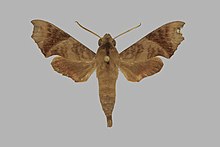Temnora sardanus
Temnora sardanus is a moth of the family Sphingidae. It is known from forests and heavy woodland from Sierra Leone to Congo and Angola, then to Zimbabwe and East Africa.[2]
| Temnora sardanus | |
|---|---|
 | |
| Scientific classification | |
| Kingdom: | |
| Phylum: | |
| Class: | |
| Order: | |
| Family: | |
| Genus: | |
| Species: | T. sardanus |
| Binomial name | |
| Temnora sardanus | |
| Synonyms | |
| |
The length of the forewings is 19–21 mm for males and 23–25 mm for females. The apex of the forewings is acute. The body is dark grey and the thorax has a prominent crest. There is also a dark dorsal spot on the last abdominal segment. The forewings are dark grey with numerous faint, irregular transverse lines. There is a large dark brown triangle with its base resting on the costa and its apex at the tornus. The proximal margin is well defined and somewhat curved and the distal side is straight and diffuse. The hindwings are uniform greyish brown, with a paler spot at tornus. The abdominal tufts are light red. Females have broader, more rounded wings. The ground colour is darker and the dark markings are more diffuse and less distinct.
Subspecies
- Temnora sardanus sardanus
- Temnora sardanus canui Darge, 1991 (São Tomé & Princípe)
- Temnora sardanus hirsutus Darge, 2004 (Tanzania)
References
- "CATE Creating a Taxonomic eScience - Sphingidae". Cate-sphingidae.org. Retrieved 2011-10-25.
- Carcasson, R. H. (1967). "Revised Catalogue of the African Sphingidae (Lepidoptera) with Descriptions of the East African species". Journal of the East Africa Natural History Society and National Museum. 26 (3): 1–173 – via Biodiversity Heritage Library.